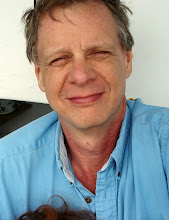In 1979, Matthew Orme, Tim Cahn, and Tom Harris formed a small speaker manufacturing company named American Hi Fidelity in Seattle.

We all contributed to the Manufacturing costs, and we assembled the speakers and crossover in Tim Canh's basement. The cabinets ere made by a now defunct company in Industry CA.
Matthew Orme designed the speaker and crossover. It was a remarkable speaker, rivaling the sound quality of the Rogers 3/5a, which was the goal.
The speaker used a Quasi 2nd order Butterworth (12 db/octave) series crossover instead of the more common parallel crossover.
T

h


e

i

dea (feel free to post corrections) was that with the series crossover, both drivers were in phase for the frequencies where they overlapped. This greatly enhances imaging. Listening tests showed that the use of zobel networks to flatten the impedance of the tweeter made the speakers "look" as though they had a flatter response, but did not sound as good.
The more components we added, the worse it sounded. The design was finalized in 1979 after many many iterations.
Like the Rogers LS3/5a, they sound best when set on stands at sitting eye level about 2 feet away from the wall. For years I used an 8" transmission line subwoofer with a passive crossover. I have since replaced it with an active subwoofer, only for it's smaller size, not better sound. In fact, the TL sounds a bit better. the Crossover diagram is supplied below.

We were fortunate in that 2 of us were ex Speakerlab employees and had the use of all their test equipment. The spectrum analyzer and it's calibrated microphone was the most useful. Using a pink noise generator, we could measure the frequency response of the system. As you see from the crossover design listening tests were used to fine tune. (The different placement of the resistors showed the same flat response, but there were audible differences.)
I just discovered all my crossover design notes, and thought it would be a good idea to publish what I had done in case anyone wished to copy the speaker design. I still had one set of speakers that I had left in my parents home for their stereo, which is where these photographs came from. They still sound great after all these years.
I do not know if the Audax drivers we used are still available, but I assume that they still make similar models. The data sheets are provided to allow you to choose drivers with similar characteristics. The 5" "woofer" was treated with an acrylic compound to dampen the cone. It looks much like white glue, and we just smeared it on with our fingers (very scientific).
As a hobbyist, I might start with something like the Tang Band W5-1685 5" Underhung Midbass Driver which is available at
http://www.parts-express.com. Of course the Crossover values would need to be recalculated for a 4 ohm driver. Tweeters are readdily available. My favorite is the KEF t27, but we used the Audax to control costs.
Component values were calculated from this article
http://razormotors.com/Constant%20Resistance%20Networks%20for%20speaker%20systems.pdfPat Snyder, the then CEO of SpeakererLab got me started when I was employed there from 6/1975 to 6/1979. Here is an article he wrote which was a free handout (the price had something to do with tax consequences)
http://razormotors.com/Crossoverdesign.pdf
The attenuation (resistor) networks were based on trial and error.
If you make a similar speaker, you will not be disappointing. Click on any image to get a full sized photo.
Enclosure Interior 0.23 cu ft ish

Final Crossover Design

Front baffle with mounted components. Notice crossover is over tweeter.



Me (Matthew Orme) after 30 years.
Like the speakers, still working.
Alex, Mike, if you read this, I miss you both very much. Apparently you are allowed to contact me, but not the reverse.



 This passive croossover was designed for an 8" TL subwoofer to be used with the 2 bookshelf speakers
This passive croossover was designed for an 8" TL subwoofer to be used with the 2 bookshelf speakers




























 h
h
 e
e i
i dea (feel free to post corrections) was that with the series crossover, both drivers were in phase for the frequencies where they overlapped. This greatly enhances imaging. Listening tests showed that the use of zobel networks to flatten the impedance of the tweeter made the speakers "look" as though they had a flatter response, but did not sound as good.
dea (feel free to post corrections) was that with the series crossover, both drivers were in phase for the frequencies where they overlapped. This greatly enhances imaging. Listening tests showed that the use of zobel networks to flatten the impedance of the tweeter made the speakers "look" as though they had a flatter response, but did not sound as good.









 This passive croossover was designed for an 8" TL subwoofer to be used with the 2 bookshelf speakers
This passive croossover was designed for an 8" TL subwoofer to be used with the 2 bookshelf speakers